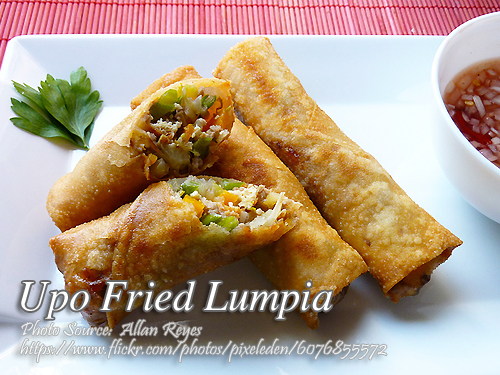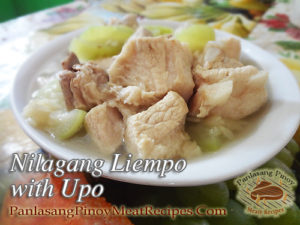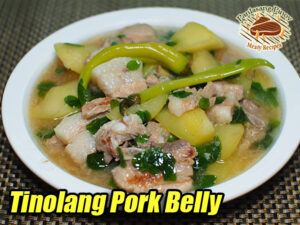Upo fried lumpia is one of the many variations of fried lumpia. The usual vegetable filling used are toge or mung bean sprouts, and other variations includes green papaya, Mexican turnip or singkamas, ubod or heart of palm. And with regards to upo, the usual Filipino dishes cooked with this vegetable is sauteed or boiled with sliced of pork. But on fried lumpia, I think this is a must try specially if you can’t think of other dishes to cook with upo.
Upo Fried Lumpia: A Nostalgic Twist on a Filipino Classic
Lumpia has always been a staple on our family table, whether for everyday meals or festive gatherings. It’s one of those dishes that can transform simple ingredients into something special. Growing up, I was most familiar with the classic lumpiang togue (mung bean sprouts) or the heart of palm variation we often had during family fiestas. However, one rainy afternoon in Tarlac, my Tita Lourdes introduced me to upo fried lumpia, and it quickly became one of my favorites.
Upo, or bottle gourd, may not be the first vegetable that comes to mind when you think of lumpia. It’s more commonly seen in hearty ginisang upo, paired with pork or shrimp, or in soupy dishes that warm the soul. But wrapped in a crisp lumpia wrapper and deep-fried to golden perfection? Upo takes on a whole new personality—light, savory, and incredibly satisfying.
Why Upo Makes a Great Lumpia Filling for Upo Fried Lumpia
Upo is known for its mild flavor and high water content, making it a versatile ingredient that absorbs the flavors of the other components it’s cooked with. When grated and cooked down, it becomes tender and subtly sweet, providing the perfect contrast to the umami-rich pork and shrimp filling. This interplay of textures and flavors is what makes upo fried lumpia stand out among other vegetable lumpia variations.
My Tita Lourdes swore by grating the upo coarsely and letting it drain in a colander before cooking. “This keeps the filling from getting soggy,” she explained, a tip she learned from her mother. It’s a small but effective step that ensures your lumpia stays crisp long after frying.
A Humble Vegetable, Elevated
Bottle gourd is a common vegetable in Filipino households, but it often doesn’t get the spotlight it deserves. Its use in lumpia is a testament to the ingenuity of Filipino cooking—making the most out of simple, everyday ingredients. Historically, dishes like this were born out of practicality. Leftover vegetables or meats were rolled into wrappers, turning scraps into something truly special.
While the history of lumpia itself traces back to Chinese influences, its evolution in the Philippines is unique. Over time, we’ve embraced local ingredients like upo, turning this simple wrap into a beloved part of our cuisine.
The Secret to Perfectly Flavorful Filling of Upo Fried Lumpia
The key to a delicious filling lies in layering flavors. This starts with sautéing garlic and onions until fragrant, followed by browning the pork. My cousin Miguel, who’s a chef in Pampanga, says this step is crucial as it develops a deep, savory base. Once the shrimp and oyster sauce are added, the filling takes on a rich, briny flavor that complements the natural sweetness of the upo.
What truly sets this recipe apart, though, is the shrimp broth. Made by boiling shrimp shells and heads, it’s a concentrated essence of the sea. By simmering the filling with this broth, every bite of your upo fried lumpia bursts with savory goodness.
Wrapping It Up
Assembling the lumpia is half the fun. My Lola used to say that the wrapping process was a family affair, and she was right. We’d sit around the dining table, with wrappers and filling laid out before us, chatting away as we rolled lumpia for merienda or dinner.
When rolling, it’s important to tuck in the sides to seal in the filling properly. My Ate Maricel taught me a trick to lightly moisten the edge of the wrapper with water to make it stick better. A good seal ensures that the filling doesn’t spill out while frying, keeping your lumpia intact and picture-perfect.
The Art of Frying Lumpia
Deep-frying may seem straightforward, but there’s a bit of finesse involved to get that golden, crispy exterior. Make sure the oil is hot enough before adding the lumpia; this prevents the wrapper from absorbing too much oil. Frying in batches is also essential to keep the oil temperature consistent. When done right, the lumpia emerges beautifully golden and irresistibly crunchy.
As kids, we couldn’t wait to grab a piece fresh out of the pan. My mom would always remind us to let it cool on paper towels first to absorb excess oil. That extra crunch, paired with a simple dipping sauce of vinegar and crushed garlic, was pure joy.
A Must-Try Recipe for Beginners
Upo fried lumpia is perfect for those just starting to explore Filipino cooking. The ingredients are simple, and the recipe teaches foundational techniques like sautéing, simmering, and frying. It’s a dish that not only satisfies your appetite but also gives you a glimpse into the resourcefulness and creativity of Filipino cuisine.
Whether you’re hosting a party or just looking for something new to cook with upo, this recipe is sure to impress. It’s a delightful way to turn a humble vegetable into a show-stopping dish. And who knows? It might just become a family favorite, as it did in mine.
Serve it hot with your favorite dipping sauce, and enjoy a little taste of nostalgia and home in every bite.
How to Cook Upo Fried Lumpia
Ingredients
- 1 1/2 kilos upo bottle gourd
- 1 medium onion chopped
- 4 cloves garlic crushed
- 1/4 kilo shrimp peeled and chopped
- 1/4 kilo ground pork
- 1 Tbsp. oyster sauce
- salt and pepper to taste
- lumpia wrapper
Instructions
How to cook Upo Fried Lumpia:
- Grate upo coarsely or slice finely. Leave in a colander and allow to drain.
- Peel shrimps and remove the head. Slice the shrimp meat into small pieces. Boil the shrimp head and shells in 1 cup water for 5 minutes. Get the broth by staining the shrimp shells. Set aside the shrimp broth.
- In a saucepan, saute garlic and onions. Add pork and saute until brown. Add shrimp and oyster sauce then saute. Pour the shrimp broth and simmer until sauce is reduced.
- Add in the upo and stir. Simmer for about 10 minutes until the liquid that comes from the upo is reduced and mixture is dry.
- Remove from heat and cool. Top one side of the lumpia wrapper with the upo filling.
- Roll tucking in both ends. Seal other side by moistening wrapper.
- Deep fry on boiling fat until golden brown.
- Drain on paper towels to absorb excess oil.
Video
Notes
Cooking Tips:
Drain the Upo Properly for a Crisp Filling
To keep your lumpia from becoming soggy, always drain the grated upo thoroughly. Let it sit in a colander to release excess moisture, then gently press it with the back of a spoon to remove any remaining liquid. This ensures your filling stays dry and crisp, even after frying.Use Shrimp Broth for Enhanced Flavor
Boiling shrimp shells and heads to create a broth adds a deep, savory flavor to your filling. Simmer the broth with the sautéed pork, shrimp, and vegetables to infuse the mixture with a rich, seafood essence. This simple step elevates the dish, making each bite flavorful and satisfying.Fry in Hot Oil for Perfectly Golden Lumpia
Ensure the oil is hot enough before frying by testing with a small piece of wrapper—it should sizzle immediately. Frying at the right temperature prevents the lumpia from soaking up excess oil and helps achieve that crunchy, golden brown exterior. For best results, fry in small batches to maintain consistent heat throughout.





